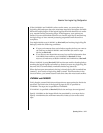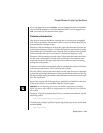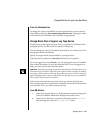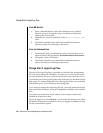
Operating OnLine 3-17
Examine Your Logical Log Configuration
If the LTAPEDEV and TAPEDEV values are the same, you must plan your
logical log file backups to leave the maximum amount of free space available
before the archive begins. If the logical log files fill while the archive is under
way, normal OnLine processing stops. If this happens, your options are
limited. You can either abort the archive to free the tape device and back up
the logical logs or leave normal processing suspended until the archive
completes.
You might decide to set LTAPEDEV to /dev/null (and not keep logical log file
backups) under the following conditions:
■ If your environment does not include a tape device but you want to
use OnLine, set both LTAPEDEV and TAPEDEV (the archive tape
device) to /dev/null.
■ If you do not care about data recovery beyond the information that
is available from archives, set LTAPEDEV to /dev/null. If data
recovery is irrelevant, set both LTAPEDEV and TAPEDEV to /dev/null.
When LTAPEDEV is set to /dev/null, OnLine does not wait for a backup before
marking the logical log files as backed up. Instead, as soon as a logical log file
becomes full, it is immediately marked as backed up (status B).
When the last open transaction in the log is closed, the log file is marked free
(status F). As a result, no logical log data is stored. This means that, in the
event of failure, you cannot restore work done since the most-recent archive.
LTAPEBLK and LTAPESIZE
Verify that the current block size and tape size are appropriate for the device
specified. The block size of the logical log tape device is specified as
LTAPEBLK. The tape size is specified as LTAPESIZE.
If LTAPEDEV is specified as /dev/null, block size and tape size are ignored.
Specify LTAPEBLK as the largest block size permitted by your tape device.
Specify LTAPESIZE as the maximum amount of data you can write to this
tape.


















